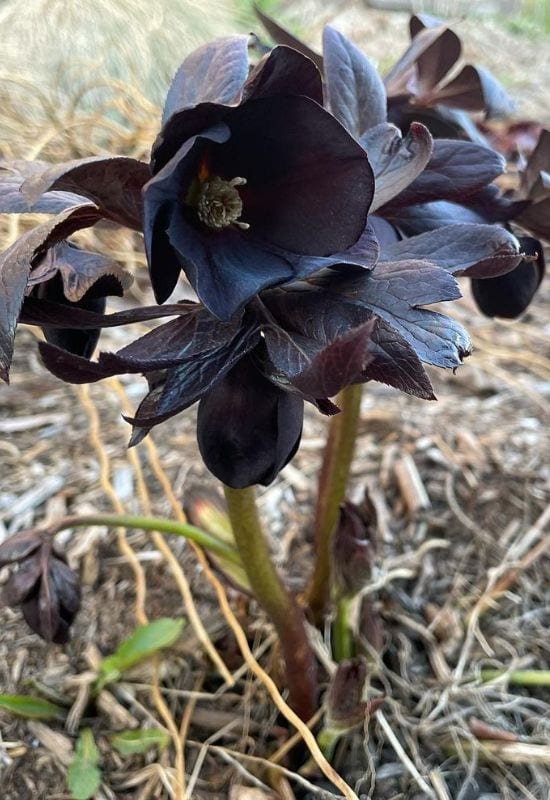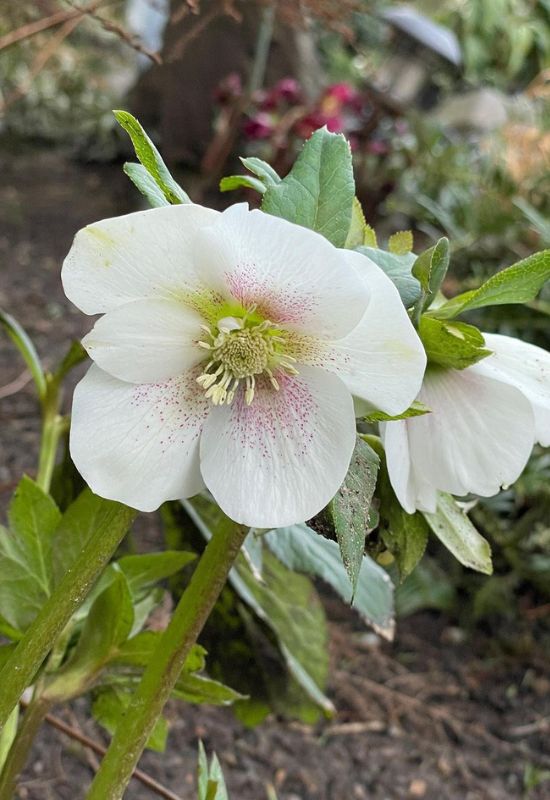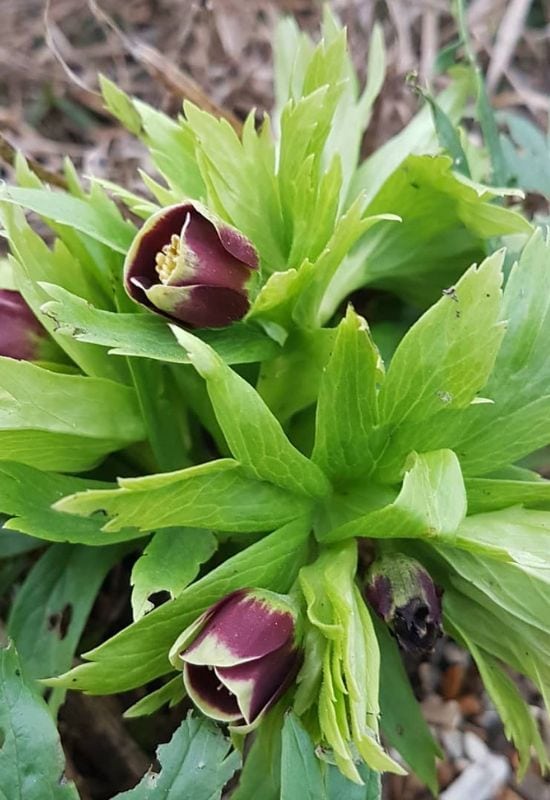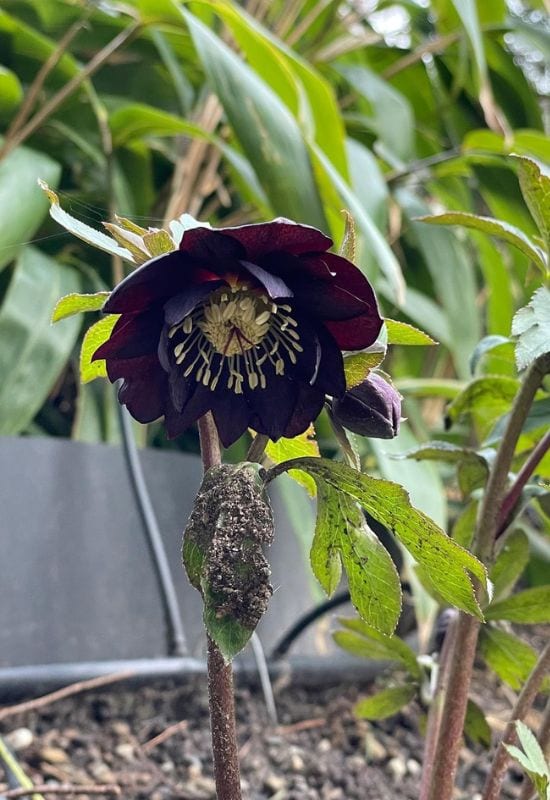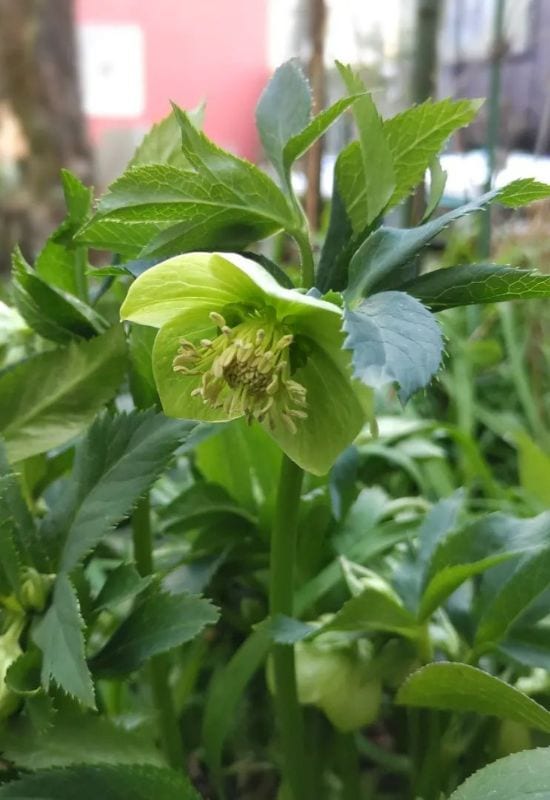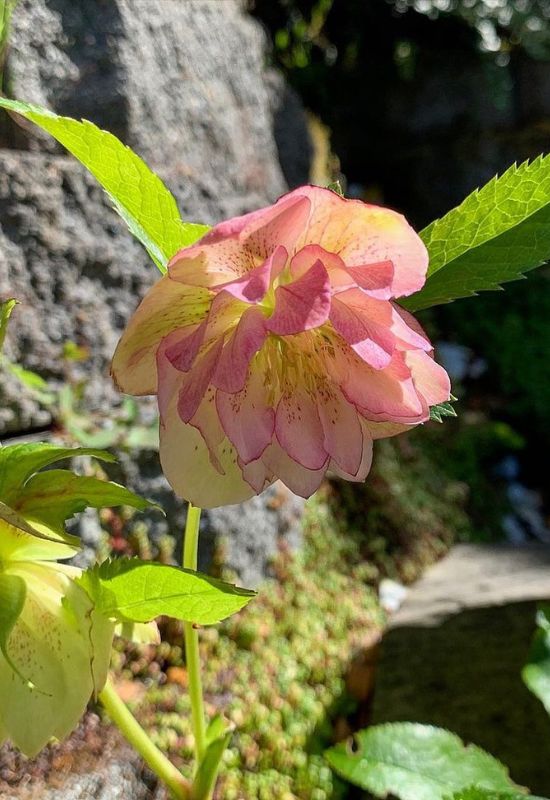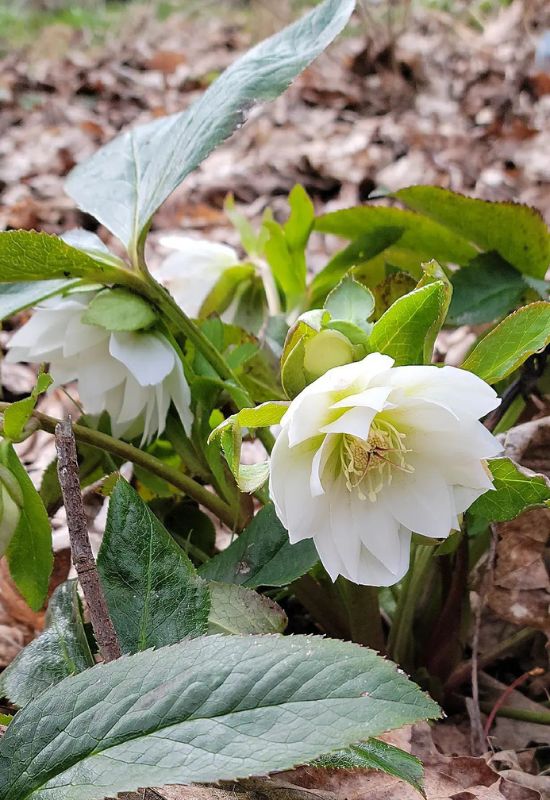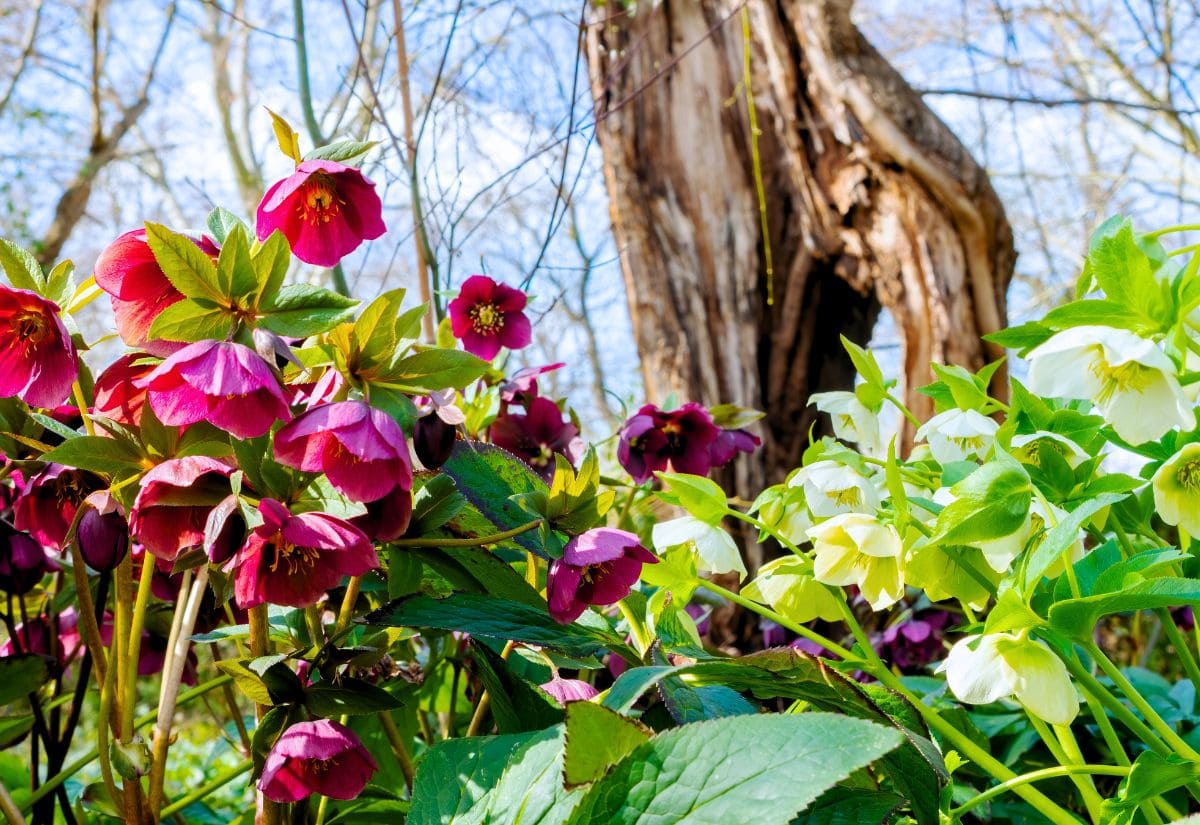
Elegantly devilish, the Hellebore is a perennial marvel, effortlessly stealing the winter spotlight with its vibrant bloom during the coldest months.
Its flowers surprise, often peeking through February-March snow, right when trees are slowly waking from winter, with the last blossoms lingering into April. Depending on the cultivar, oriental hellebores can have either single or double rose-like flowers, showcasing a spectrum of colors from from icy whites to deep blacks and even unique greens. Some even boast striking spots or streaks of canary yellow or blue.
Yet, what sets hellebores apart is their mastery of rare and sophisticated shades, including every tint of green, pink, purple, and even delicate hues like cream, rose, lavender, chartreuse, coral, and salmon.
Their lush, often evergreen foliage, with deep lobes and a glossy finish, provides perfect ground cover. Even better? They’re deer-resistant. Truly, hellebores offer one of the most refined color palettes for any garden.
As easy-to-maintain perennials, they’re versatile. Whether in flower beds, rock gardens, or at the base of deciduous trees alongside snowdrops and crocuses, they bring vibrant life to winter landscapes. Their spontaneous propagation makes them ideal for shaded naturalized and woodland areas too.
Known also as Lenten roses, winter roses, or Christmas roses, the 20 species of Helleborus—along with their numerous subspecies and cultivars. Interestingly, despite the rose-like names, these Eurasian natives don’t belong to the rose family (Rosaceae), but to the Ranunculaceae family.
Of modest beginnings but with a regal spirit, the hellebore stands as the true winter queen, with both the classic Christmas rose and the color-rich oriental hellebores as testimony. The real challenge? Picking the type of hellebore for your garden.
We’ve handpicked 16 ornamental hellebore varieties for you, featuring both classic and unique double flowers.
15 Colorful Types of Hellebores to Glam Up Your Winter and Spring Garden
We picked 15 between natural species, hybrids and cultivars, all in different shades, some strong (like black) and others very delicate; we could not list all the varieties available, but chose a list of very different ones:
We will start with a variety of Lenten rose, or hellebore, that has a very delicate color, just to start off on a soft note…
1. ‘Ivory Prince’ Hellebore (Helleborus x nigersmithii ‘Ivory Prince’)
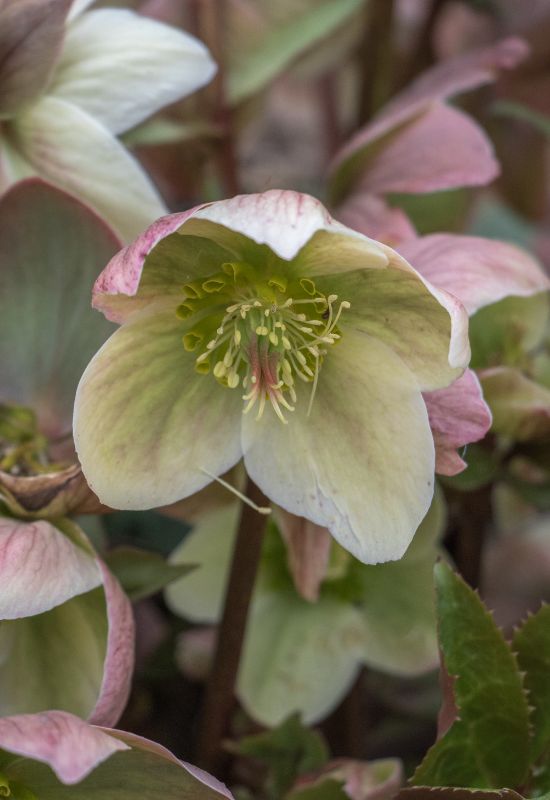
We can start with a hellebore, or Christmas rose variety, that has a soft but moody and deep personality. The single blooms that grow on stems just above the evergreen foliage are round, with 5 equally round petals that open fully to a flat saucer shape, to about 2 to 3 inches wide (5.0 to 7.5 cm) and they do it at a very unusual time, un winter of course.
Creamy white in shade on the inside, they display a pastel shade of lavender rose on the outside, really visible when in bud. Ivory and green form two circles in the middle, with stamen and pistils.
The tepals will change tonality when they mature, taking on chartreuse tints. The he burgundy stems on which they open lead you down to the large palmate leaves, dark green and leathery, with silver veins and dark purple overtones.
A classic looking variety, ‘Ivory Prince’ is a common choice for naturalized areas where you want to have even groundcover, but with a twist of elegance and dark thoughtfulness but also suave blooms.
2. ‘New York Night’ Hellebore (Helleborus ‘New York Night’)
Meet a dark beauty, the gothic queen of hellebores: ‘New York Night’! This lenten rose of the Honeymoon Series, hybridized by Walters Gardens takes its name from the deep, nocturnal color of its flowers… In fact, they are of the darkest burgundy purple ever, round and single, and you dan see delicate veining on the petals.
Opening to about 2.5 to 3.0 inches across (6.0 to 7.5 cm), they are also fairly late bloomers: in fact, they will start their floral display in late winter and continue all the way to the end of spring! However, its main flowering season in in April and May, when it will give your garden a very unusual spectacle, and it loves humid, shady and naturalized places, like woodland gardens, where this shady beauty will naturalize and spread. The semi glossy, deep green palmate foliage will cover the soil all year round, and deer will not even touch it.
Of course, ‘New York Night’ hellebore is the variety you want to grow if you have a taste for unusual, dark colors, and if you like to surprise visitors to your land or garden with what we can call “black flowers”.
3. ‘Sandy Shores’ Hellebore (Helleborus ‘Sandy Shores’)
From noir to super romantic, lenten roses never cease to amaze us: enter ‘Sandy Shores’ hellebore, still from the popular Honeymoon series. What makes this variety really exceptional is the soft, rare and refined palette it displays on its blooms. Each flower head is about 3 inches across (7.5 cm) and they display a pale pastel rose color inside, which blushes to a halo of vibrant purple towards the center.
The wavy petals, however,are quite different on the outside, where a shades of deep pink and coral mix seamlessly, again, fading to purplish towards the stem, as if painted by a Renaissance Master! This too is a late blooming cultivar, and it will start gracing your garden with its blossoms in mid spring, and by early summer you will be left with the mid to dark, decorative leaves that will keep you company all year round, quite glossy too!
‘Sandy Shores’ will grow well in naturalized and woodland areas as well, but given its sweet and rare coloring and soft personality, you may prefer to have it in a shady flower bed close to your house, where you can fully enjoy it at close distance!
4. Stinking Hellebore (Helleborus foetidus)
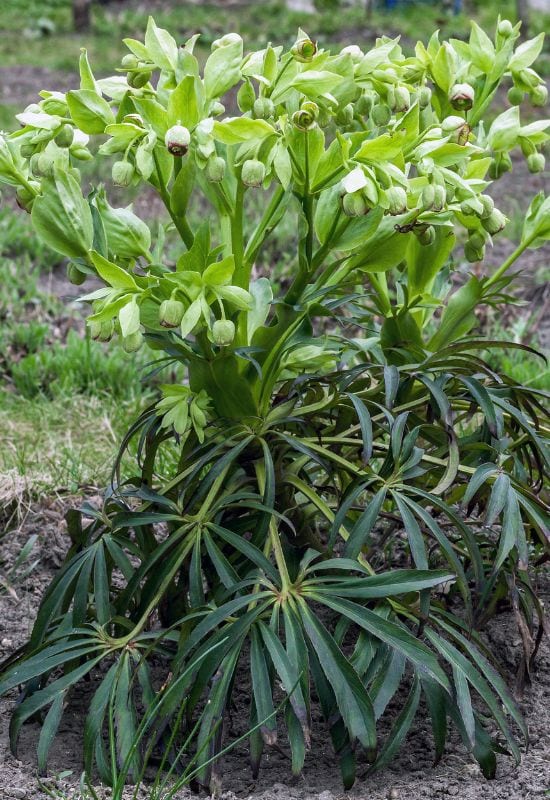
Did we say that Christmas roses specialize in very unusual colors? And stinking hellebore, a natural species from Central and Southern Europe, and Asia Minor is the proof! It has smaller blooms than other varieties, only about 1 inch across (2.5 cm), and bell shaped, quite delicate and unusual.
But then you will notice its bright chartreuse green color, and that will literally wow you and your visitors, as it has done with the jury of the Award of Garden Merit by the Royal Horticultural Society, which of course, gave it the sought after prize! The blossoms have a line of purple, like lipstick at the edges, to draw your eye in… The evergreen foliage takes on the pale green theme, for an overall super bright, refreshing and reinvigorating look!
A late winter to early spring bloomer, it puts you on guard with its name; stinking hellebore has a strong, aromatic – but apparently very unpleasant – odor if you strike it… but apart from this, it os an excellent choice for both gardens and naturalized areas, also because deer and other animals will leave this smelly beauty alone… And it’s one of the few varieties you can grow in sunny spots.
5. ‘Red Sapphire’ Hellebore (Helleborus x hybridus ‘Red Sapphire’)
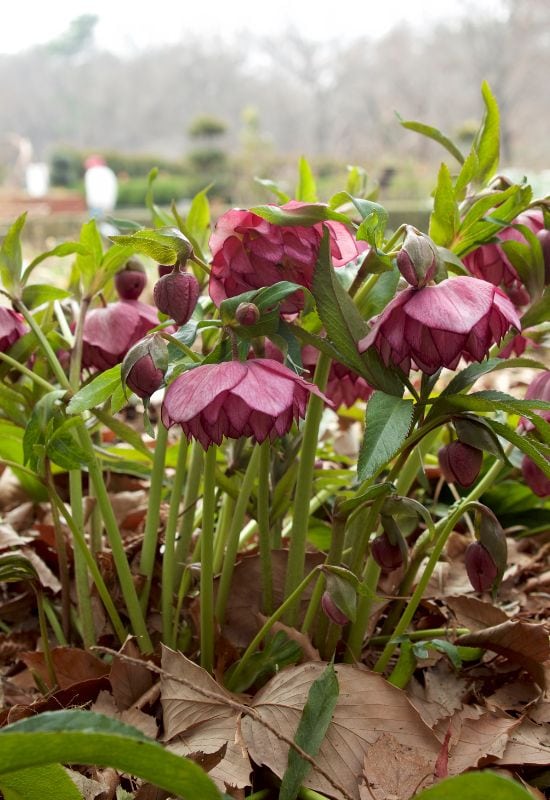
‘Red Sapphire’ is a hellebore variety of the Winter Jewel Series with the personality of a great protagonist! Starting its floral display in late winter, it will spark up your garden with its large and fully double flowers till early spring, sometimes beyond, each reaching 3.3 inches across (8.0 cm)! They come very profusely and the pointed petals, regularly arranged in concentric rings, give it the appearance of a lotus.
This is also because the white center contrasts so strongly with the vibrant and energetic cherry to ruby red color of its many tepals! The blossoms of this luxurious beauty also have a delicately nodding habit, so they look like very precious gems as they open on the strong stems that bring them just above the glossy and leathery evergreen foliage!
While it is an expensive looking cultivar, perfect for flower beds and borders, ‘Red Sapphire’ double hellebore is also suitable for areas of your garden where you dedicate little time, because it is quite sturdy and it naturalizes and propagates spontaneously.
6. ‘Flower Girl’ Hellebore (Helleborus ‘Flower Girl’)
‘Flower Girl’ hellebore is a lenten rose with a delicate look and a little twist… The flowers are about 3 inches across (7.5 cm) and double, with a lovely tuft of cream yellow pistils in the center, set against a small halo of very pale green… Around them, you will get the inner circle of petals, which are wavy, white to pale rose with purple edges.
The outer tepals, instead, are of the same color, but flat… Forming lovely bouquet like groups of nodding blooms, they will start start a bit late, in early summer, andcontinue blossoming roughly till the end of April.
It is a variety of the Wedding Party Series, and surely you can see why its personality is just perfect for these events! What’s more, the floral display is set off beautifully by the contrast with the dark, glossy and evergreen foliage of deeply lobed leaves.
Easy to grow and romantic, ‘Flower Girl’ will do well in a sheltered location, under trees or in shady borders and beds, and it will always bring a warm smile on your face.
7. Syncarpus Hellebore (Helleborus vesicairus)
Syncarpus hellebore is actually a category, but it has only one species, Helleborus vesicariusnative of mountain regions of Syria and Turkey. It is actually a rare variety, hard to find quite expensive as well, at over 20 dollars a plant! But it is worth having if you are a collector! To start with, its broad foliage is finely cut, and this gives it a very thin texture, but unusually, it is not evergreen! It will emerge in fall and stay on through winter and spring, then die back for the summer months.
It is usually bright and light green, similar to that of celery, and the flowers come on leafy stems above it. They are bell shaped, almost tubular, and small, about 0.4 inches wide (1.0 cm) and 0.8 inches long (2.0 cm), nodding and gracious.
They are usually purple to maroon, but they fade to greenish shades and white as well. They will produce large seed pods, similar to balloons, up to 6 inches long (15 cm) and 4 inches wide (10 cm), and they will fall off and roll about once ripe!
Hellebousvesicariusis a very unusual variety of hellebore; it is rhizomatous, and growers suggest treating it like a bulb, yet another uncommon trait is that it likes to be fully dry when it’s dormant, during the summer months. Finally, it is regarded a hard species to grow.
8. ‘Black Onyx’ Hellebore (Helleborus x hybridus ‘Black Onyx’)
As the name suggests, ‘Black Onyx’ hellebore, a lenten rose of the Winter Jewel Series, is possibly the darkest of all Christmas roses! The large blooms, in fact, about 3 inches across (7.5 cm) have a very, very deep shade of purple with bluish hints that make it appear almost the same color of a moonless night! With white anthers on pistils and thin red stamens that rise from a greenish patch in the middle of the bloom, the pointed petals (tepals) of this double flowered variety look very striking and exceptional indeed when they emerge in February! They will certainly become the focus of attention in your shady beds or in naturalized areas, or even in a rock garden, also thanks to the rich green, evergreen foliage with purple blushes on the edges and under pages.
While ‘Black Onyx’ has a really exotic as well as gothic touch to it, this hellebore will easily self seeds and it will give you no hassle, which makes it perfect for ground cover or to underplant shrubs and trees and suitable for warmer climates.
9. Green Hellebore (Helleborus multifidus ssp. bocconei)
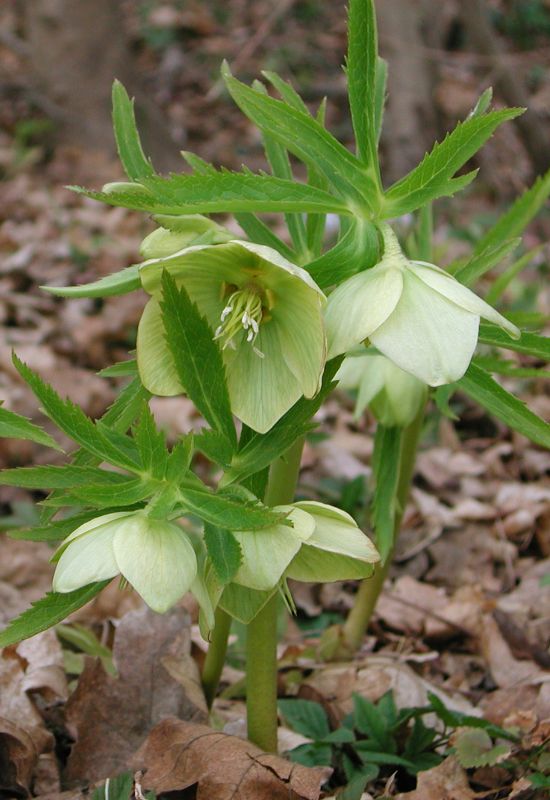
This Italian lenten rose is quite widespread in the forests of the peninsula, and yes – it does have green flowers! Single and star shaped saucers, with lovely white anthers in a round tuft in the middle, the blooms are about 2 inches across (5.0 cm) or a bit more, and they nod beautifully on the stems with their pale, lime green color. Sometimes they do take on bright tonalities as well, and rarely a dash of yellow.
It is also one of the longest bloomers of all hellebores, giving you a floral display that lasts all the way from January to April, and I have seen it flowering even earlier and later. What’s more, the blossoms have a sweet fragrance of gooseberries, which really suits its woodland personality. The bright green foliage is lush and lobed, and while it is deciduous, it is excellent as groundcover.
One of the best varieties to naturalize, green hellebore is a classic of Sicily and a very refreshing garden friend to grow in shady spots and to allow to propagate freely.
10. ‘Party Dress Pink’ Hellebore (Helleborus x hybridus ‘Party Dress Pink’)
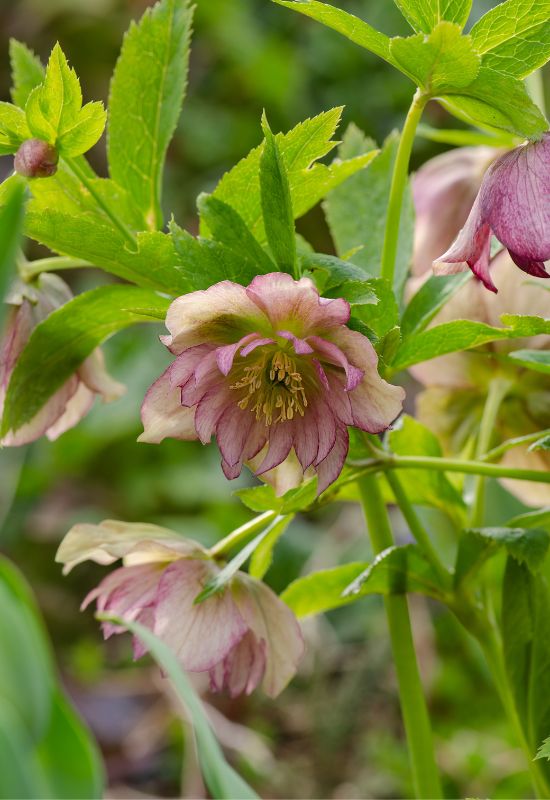
Here’s a very unusual looking and striking lenten rose for you: ‘Party Dress Pink’ hellebore! It really has a personality like no other thanks to its blooms, that look a bit like ballerina skirts, or sea anemones! In fact, the fully double flowers have bending tepals that also fold in the middle, and they drop down from the nodding blossoms like frills, reaching 3.3 inches across (8.0 cm)! Very generous with its floral displays and starting in late winter, it will warm up your garden with its deep pink to bright red color, painted on it as if with very gentle and fine dashes.
The veins are clearly visible, giving you the effect of pencil on drawing paper. Perfect for shady spots, this is a semi evergreen variety; the leathery and glossy broad and deeply lobed leaves will stay on during the cold months in warm climates.
‘Party Dress Pink’ will like a sheltered spot under trees but also in borders, where it can really bring a splash of color and energy when most other flowering plants will be asleep.
11. Ligurian Hellebore (Helleborus liguricus)
Here’s another lovely species of Christmas rose from Italy: Ligurian hellebore, a variety that grows on the famous riviera, gracing the wild areas of it mountainous inland. It is not very common as a home garden plant, but it is really worthwhile, also because it is low maintenance and easy to grow.
The floral display is long, and it covers the whole of winter! They are nodding and cup shaped, with slightly pointed petals (tepals), not huge, but still showy, about 2 inches across (5.0 cm). They are white overall, but blushes of lime green will be visible here and there, especially on the outside.
But what makes these sweet looking blossoms really unique is the strong lemon scent they give off. The deeply cut and leathery glossy leaves will be with you all year round as well!
Ligurian hellebore is ideal for naturalized areas, where it will spread and give you blossoms all over winter, but don’t be afraid to grow it in garden beds or border fronts if you need flowers in this difficult time of the year!
12. ‘Citron’ Hellebore (Helleborus x hyridus ‘Citron’)
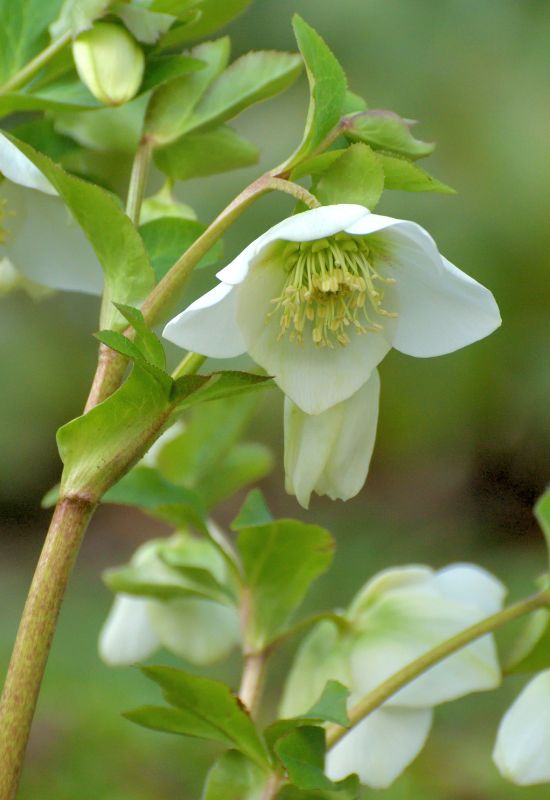
When we think of Christmas roses, we seldom imagine them in the color of gold and of the Sun… But this cultivar from the UK manages to bring out this unusual tonality, and it is called ‘Citron’ hellebore. The name is quite spot on, because its round and bowl shaped single flowers have a very bright shade of yellow, that edges on the canary and lemon.
Full of energy and very luminous, they will start lighting up your garden in the middle of winter and keep going till early spring, with their 2 to 3 inches in diameter (5.0 to 7.5 cm). Clump forming, the foliage is dark green and quite glossy, a perfect lush ground cover for all the seasons!
You may love ‘Citron’ hellebore because it touches chromatic notes that other lenten roses don’t, or because it will bring you lots of energy for a long time with its blooms. And this variety too will naturalize easily and fast!
13. Purple Hellebore (Helleborus purpurascens)
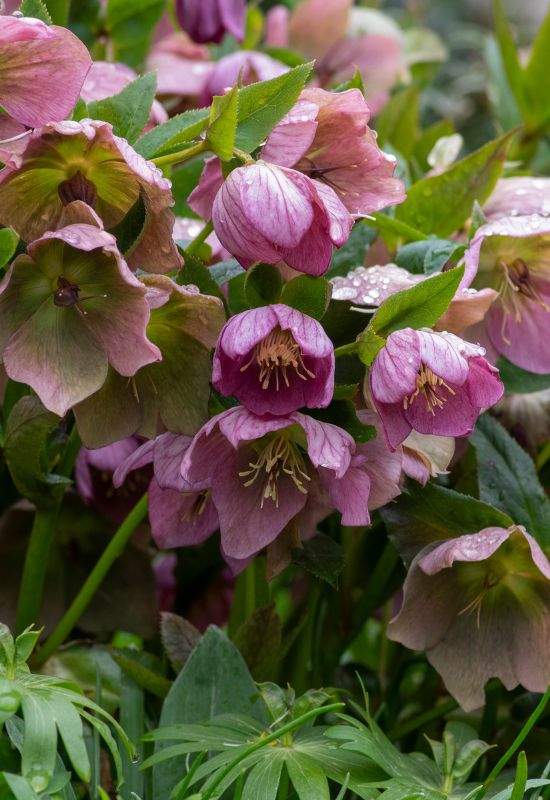
This variety of Christmas rose has two names, and they will puzzle you: purple hellebore or blue ears lenten rose… and there is a very good reason for it… This speciesfromCentral and Eastern Europe (Hungary, Slovakia, Poland and Romania) is a real chameleon! Its nodding flowers, bowl to saucer shaped are a real surprise when they appear in the winter months…
They can be on the pale purple tonality, or all the way to maroon, and sometimes the outsides of the tepals can even look almost back. But they can also take on a brilliant violet range, and even be smokey blue! It is in fact one of the most eclectic varieties when it comes to colors, and the reddish purplish stems that hold them will also add a great kaleidoscopic touch to your garden.
Then, imagine setting this floral display against very glossy and deeply cut super glossy rich green leaves, sometimes with emerald hues, and you can see why it’s so fantastic!
Intriguing but easy to grow, purple (or blue ears) hellebore will still ask for very little care and it will settle in quite well in shady or even sunny spots in your garden, spreading and becoming a very colorful winter protagonist of your land!
14. ‘Phoebe ‘ Hellebore (Helleborus x hybridus ‘Phoebe’)
Here is another really spectacular hellebore for you, ‘Phoebe’ lenten rose! Its large blooms reach a maximum of 3.3 inches across (8.0 cm), and this alone makes them quite showy indeed. But it this evergreen perennial cultivar has much more to offer you… Its fully double flowers have broad but wavy, slightly frilled petals that look very delicate, a bit like silk, or a very soft material forming a lovely rosette.
Starting in late winter, they have a pastel rose but color, but the edges have a very thin blushing line of lavender on them, while in the center of each tepal, lots of tiny specks, or dots, of pure magenta purple decorate as if with cherry dusting, or tiny droplets scattered by a painter’s brush.
The centers will show you a refreshing lime green color, and the pale yellow anthers will finally bring you a flash of gentle light. The bright green foliage keeps the luminous quality of this variety and enhances it even further.
A real work of art, ‘Phoebe’ hellebore is very romantic and old world looking, but certainly a prima donna wherever you grow it, in beds, under shrubs, in natural areas or just in front of your main door!
15. ‘Sparking Diamond’ Hellebore (Helleborus x hybridus ‘Sparkling Diamond’)
After such a vast range of exquisite, even rare colors, we could only conclude our list of Christmasroses with a variety of the color of snow… And there are really many, including quite a few natural species, but one really stands out: ‘Sparking Diamond’ hellebore, a member of the Winter Jewels Series! To start with, its blossoms are really large, about 3.3 inches in diameter (8.0 cm), and fully double.
The tepals are really elegant, diamond shaped, and regularly arranged in concentric circles. The blossoms form very open saucers that will definitely remind you of lotus! With a bright green center, where the pale to cream yellow anthers form lovely crowns, they are of the most candid white shade you will ever see! Pure and luminous, they sometimes blush very gently with a plum purple line on the very margins, and at other rimes, a few gentle specks of the same tonality appear on the petals. The evergreen foliage, decorative, broad and lobed, is very glossy indeed and emerald!
Arguably the most candid flower you can have during the winter season, ‘Sparking Diamond’ is sheer light and purity for most garden areas, as long as sheltered; you could wish to have it in your main flower beds to lift them up during the cold months, or let it go wild and spread naturally in a woodland area – or, why not? – both!
Hellebore: the Queen of Winter and Rare Colored Blooms!
Of course, there are many more varieties of hellebore you can grow, including natural species, hybrids and cultivars. And it’s not been easy to pick 15 only… Lenten roses are really exceptional flowering perennials though.
To start with, they blossom when very few other plants will – if at all – and even in cold countries! But what really makes these short perennials exceptional is the exquisite palette of colors they offer – from white to almost black via rare shades like coral, lime, salmon… It is just a real queen of gardens and woodland areas, and a very easy one to grow indeed!
A final tip: it really grows well from seed, so, don’t waste the seed pods… Just scatter them in woods and parks, and you will smile when you see them blossom in the cold of winter!

Written By
Adriano Bulla
After many years as an academic in London, Adriano Bulla became a writer, publishing books like A History of Gardening, Organic Gardening and Elements of Garden Design; he then decided to become a gardener, following his childhood dream, and has been following his dream writing and gardening professionally in Southern Europe, where he has specialized in new and innovative organic gardening fields and techniques, like permaculture, regenerative agriculture, food forests and hydroponics.

